Tutorial: Microsoft Entra single sign-on (SSO) integration with F5
In this tutorial, you'll learn how to integrate F5 with Microsoft Entra ID. When you integrate F5 with Microsoft Entra ID, you can:
- Control in Microsoft Entra ID who has access to F5.
- Enable your users to be automatically signed-in to F5 with their Microsoft Entra accounts.
- Manage your accounts in one central location.
To learn more about SaaS app integration with Microsoft Entra ID, see What is application access and single sign-on with Microsoft Entra ID.
Prerequisites
To get started, you need the following items:
- A Microsoft Entra subscription. If you don't have a subscription, you can get a free account.
- F5 single sign-on (SSO) enabled subscription.
Scenario description
In this tutorial, you configure and test Microsoft Entra SSO in a test environment.
F5 supports SP and IDP initiated SSO.
F5 SSO can be configured in three different ways:
Adding F5 from the gallery
To configure the integration of F5 into Microsoft Entra ID, you need to add F5 from the gallery to your list of managed SaaS apps.
- Sign in to the Microsoft Entra admin center as at least a Cloud Application Administrator.
- Browse to Identity > Applications > Enterprise applications.
- To add new application, select New application.
- In the Add from the gallery section, type F5 in the search box.
- Select F5 from results panel and then add the app. Wait a few seconds while the app is added to your tenant.
Alternatively, you can also use the Enterprise App Configuration Wizard. In this wizard, you can add an application to your tenant, add users/groups to the app, assign roles, as well as walk through the SSO configuration as well. Learn more about Microsoft 365 wizards.
Configure and test Microsoft Entra single sign-on for F5
Configure and test Microsoft Entra SSO with F5 using a test user called B.Simon. For SSO to work, you need to establish a link relationship between a Microsoft Entra user and the related user in F5.
To configure and test Microsoft Entra SSO with F5, complete the following building blocks:
- Configure Microsoft Entra SSO - to enable your users to use this feature.
- Create a Microsoft Entra test user - to test Microsoft Entra single sign-on with B.Simon.
- Assign the Microsoft Entra test user - to enable B.Simon to use Microsoft Entra single sign-on.
- Configure F5-SSO - to configure the single sign-on settings on application side.
- Create F5 test user - to have a counterpart of B.Simon in F5 that is linked to the Microsoft Entra representation of user.
- Test SSO - to verify whether the configuration works.
Configure Microsoft Entra SSO
Follow these steps to enable Microsoft Entra SSO.
Sign in to the Microsoft Entra admin center as at least a Cloud Application Administrator.
Browse to Identity > Applications > Enterprise applications > F5 > Single sign-on.
On the Select a single sign-on method page, select SAML.
On the Set up single sign-on with SAML page, click the edit/pen icon for Basic SAML Configuration to edit the settings.

On the Basic SAML Configuration section, if you wish to configure the application in IDP initiated mode, enter the values for the following fields:
a. In the Identifier text box, type a URL using the following pattern:
https://<YourCustomFQDN>.f5.com/b. In the Reply URL text box, type a URL using the following pattern:
https://<YourCustomFQDN>.f5.com/Click Set additional URLs and perform the following step if you wish to configure the application in SP initiated mode:
In the Sign-on URL text box, type a URL using the following pattern:
https://<YourCustomFQDN>.f5.com/Note
These values are not real. Update these values with the actual Identifier, Reply URL and Sign-on URL. Contact F5 Client support team to get these values. You can also refer to the patterns shown in the Basic SAML Configuration section.
On the Set up single sign-on with SAML page, in the SAML Signing Certificate section, find Federation Metadata XML and select Download to download the certificate and save it on your computer.

On the Set up F5 section, copy the appropriate URL(s) based on your requirement.

Create a Microsoft Entra test user
In this section, you'll create a test user called B.Simon.
- Sign in to the Microsoft Entra admin center as at least a User Administrator.
- Browse to Identity > Users > All users.
- Select New user > Create new user, at the top of the screen.
- In the User properties, follow these steps:
- In the Display name field, enter
B.Simon. - In the User principal name field, enter the username@companydomain.extension. For example,
B.Simon@contoso.com. - Select the Show password check box, and then write down the value that's displayed in the Password box.
- Select Review + create.
- In the Display name field, enter
- Select Create.
Assign the Microsoft Entra test user
In this section, you'll enable B.Simon to use single sign-on by granting access to F5.
Sign in to the Microsoft Entra admin center as at least a Cloud Application Administrator.
Browse to Identity > Applications > Enterprise applications > F5.
In the app's overview page, find the Manage section and select Users and groups.
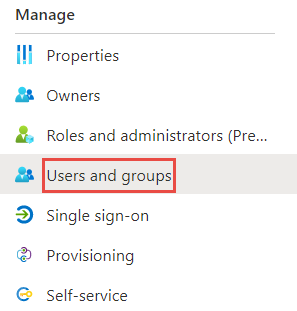
Select Add user, then select Users and groups in the Add Assignment dialog.

In the Users and groups dialog, select B.Simon from the Users list, then click the Select button at the bottom of the screen.
If you're expecting any role value in the SAML assertion, in the Select Role dialog, select the appropriate role for the user from the list and then click the Select button at the bottom of the screen.
In the Add Assignment dialog, click the Assign button.
Configure F5 SSO
Configure F5 single sign-on for Advanced Kerberos application
Open a new web browser window and sign into your F5 (Advanced Kerberos) company site as an administrator and perform the following steps:
You need to import the Metadata Certificate into the F5 (Advanced Kerberos) which will be used later in the setup process. Go to System > Certificate Management > Traffic Certificate Management >> SSL Certificate List. Click on Import of the right-hand corner.
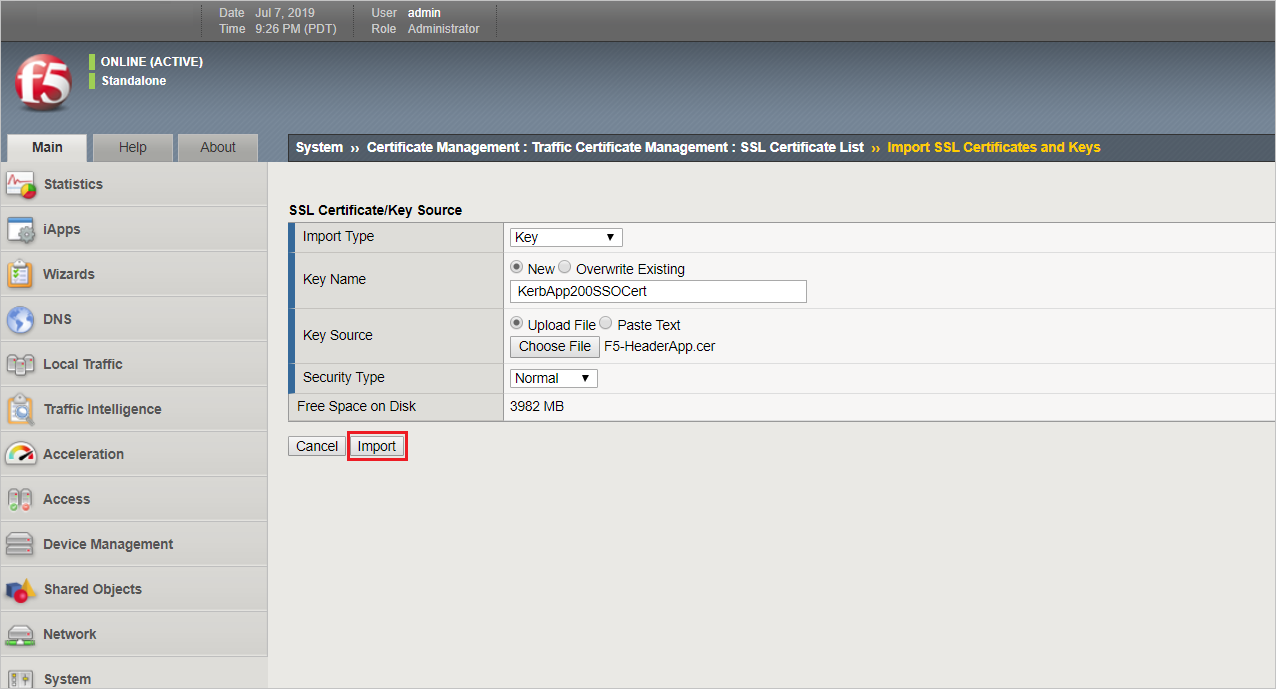
To setup the SAML IDP, go to Access > Federation > SAML Service Provider > Create > From Metadata.
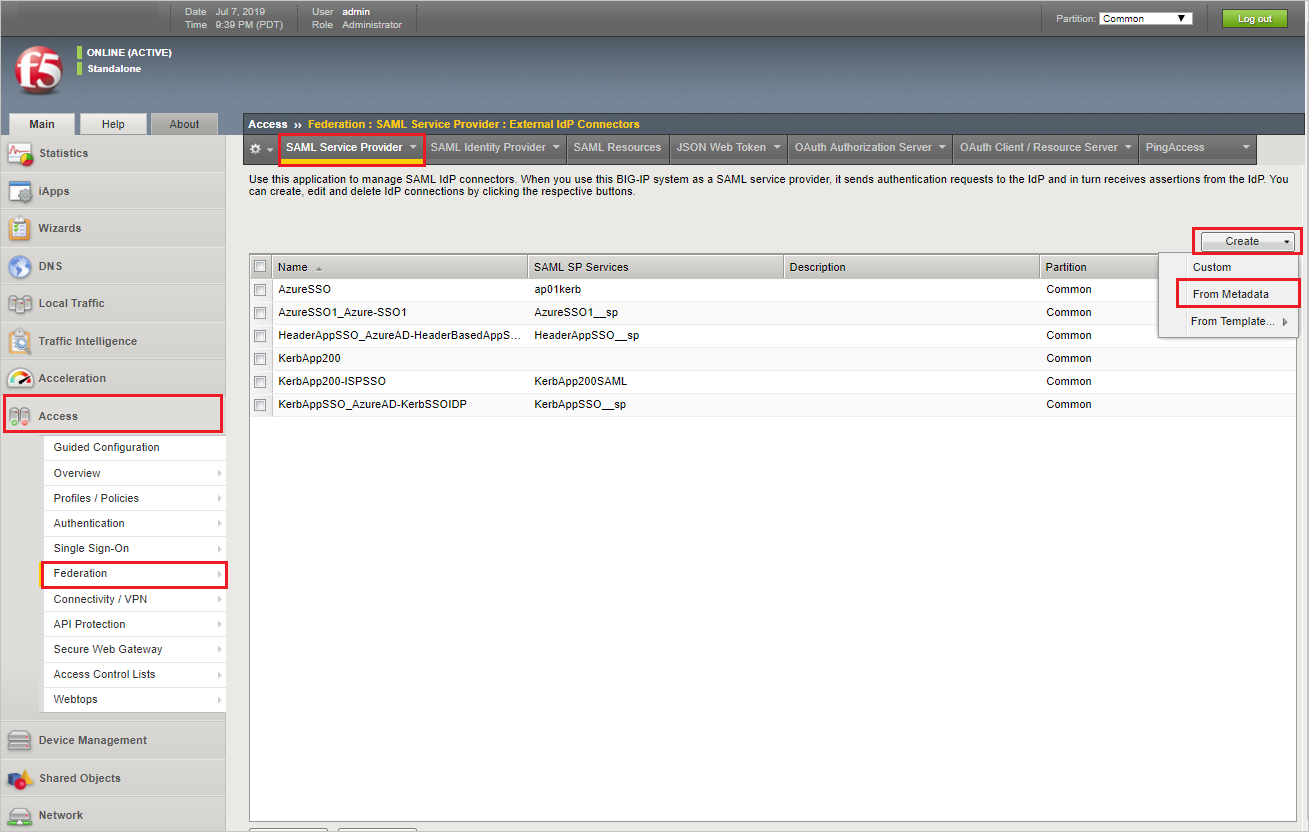
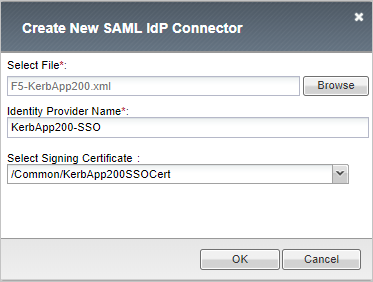

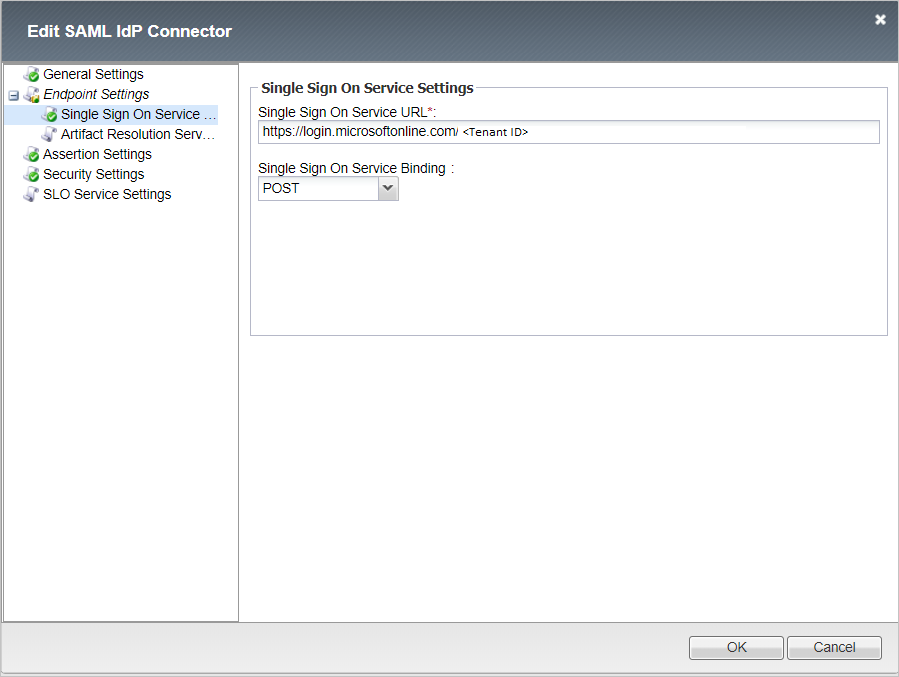
Specify the Certificate uploaded from Task 3
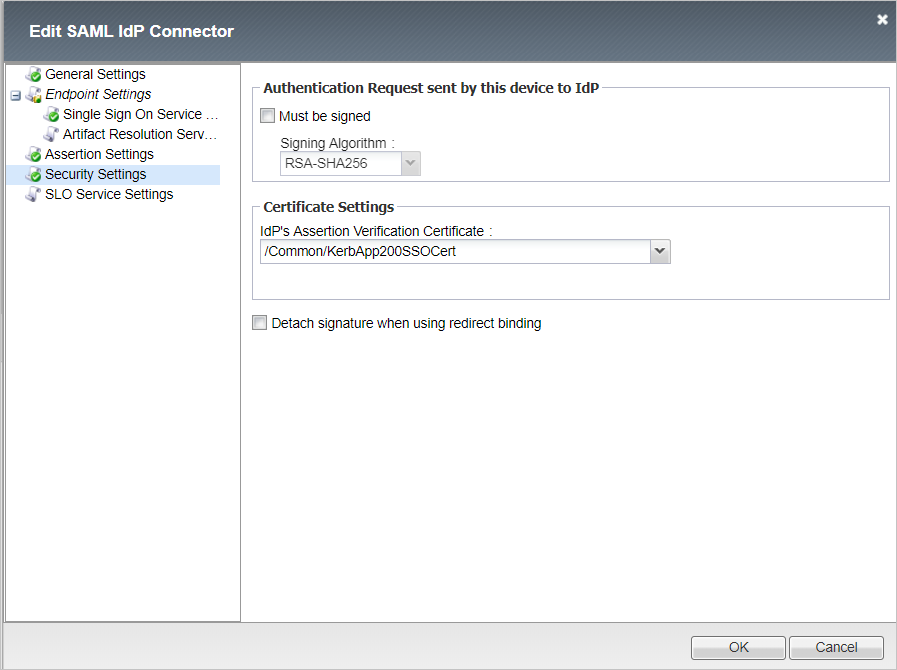

To setup the SAML SP, go to Access > Federation > SAML Service Federation > Local SP Services > Create.
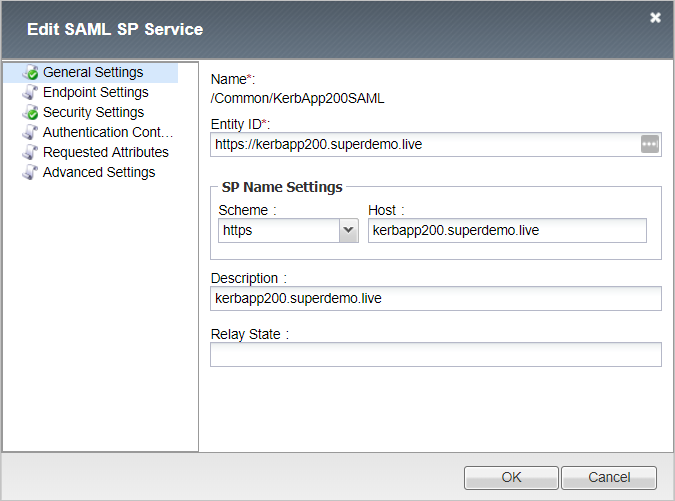
Click OK.
Select the SP Configuration and Click Bind/UnBind IdP Connectors.

Click on Add New Row and Select the External IdP connector created in previous step.

For configuring Kerberos SSO, Access > Single Sign-on > Kerberos
Note
You will need the Kerberos Delegation Account to be created and specified. Refer KCD Section ( Refer Appendix for Variable References)
Username Source
session.saml.last.attr.name.http://schemas.xmlsoap.org/ws/2005/05/identity/claims/givennameUser Realm Source
session.logon.last.domain
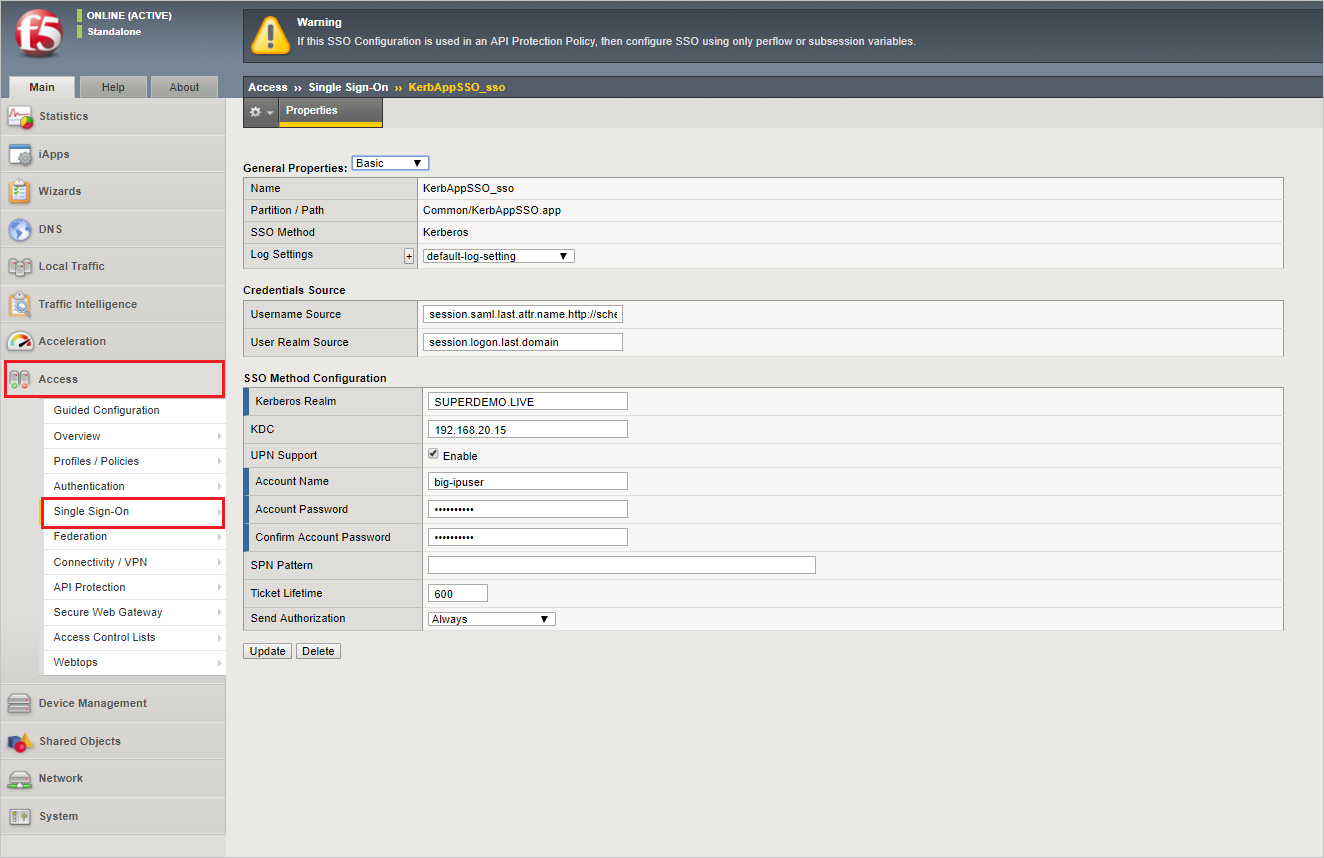
For configuring Access Profile, Access > Profile/Policies > Access Profile (per session policies).



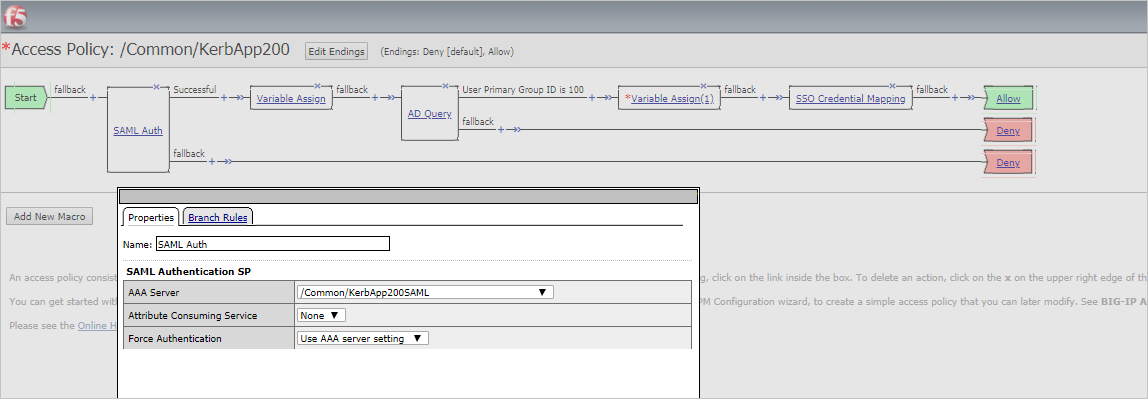
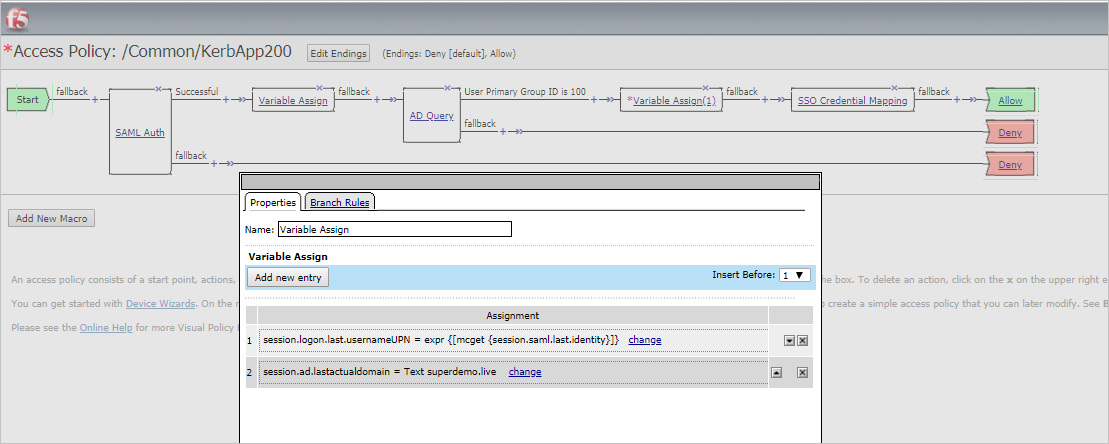
session.logon.last.usernameUPN expr {[mcget {session.saml.last.identity}]}
session.ad.lastactualdomain TEXT superdemo.live
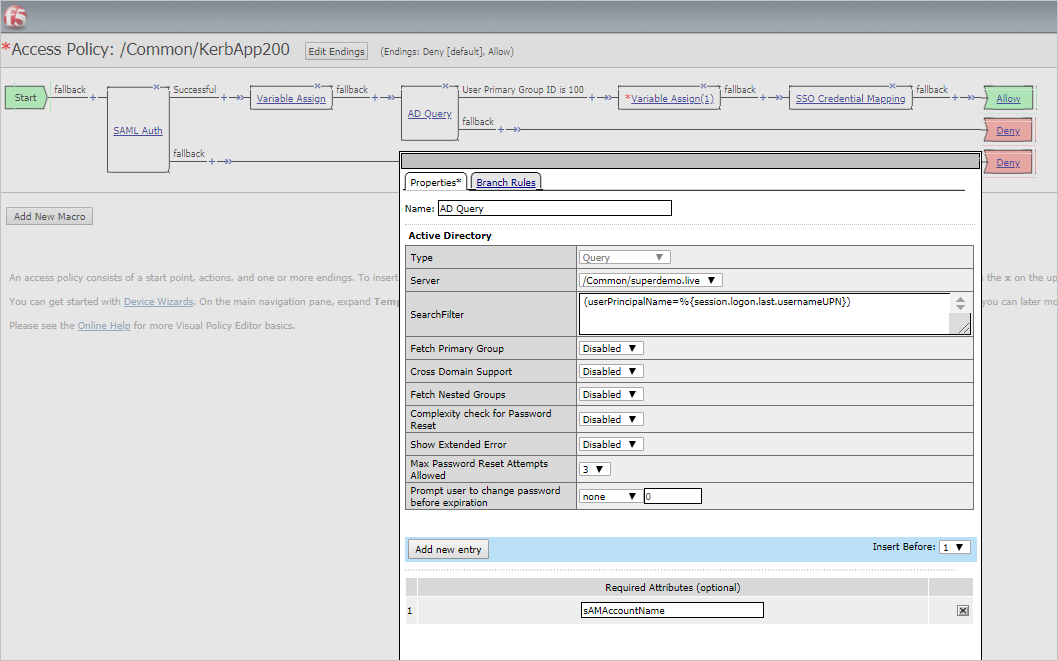
- (userPrincipalName=%{session.logon.last.usernameUPN})
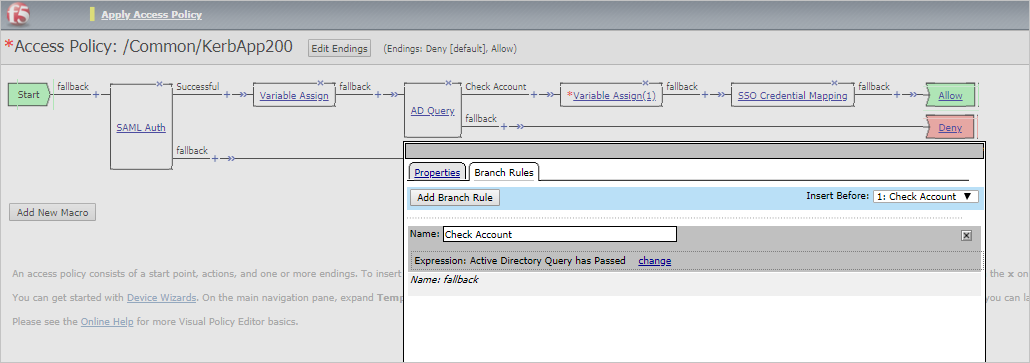
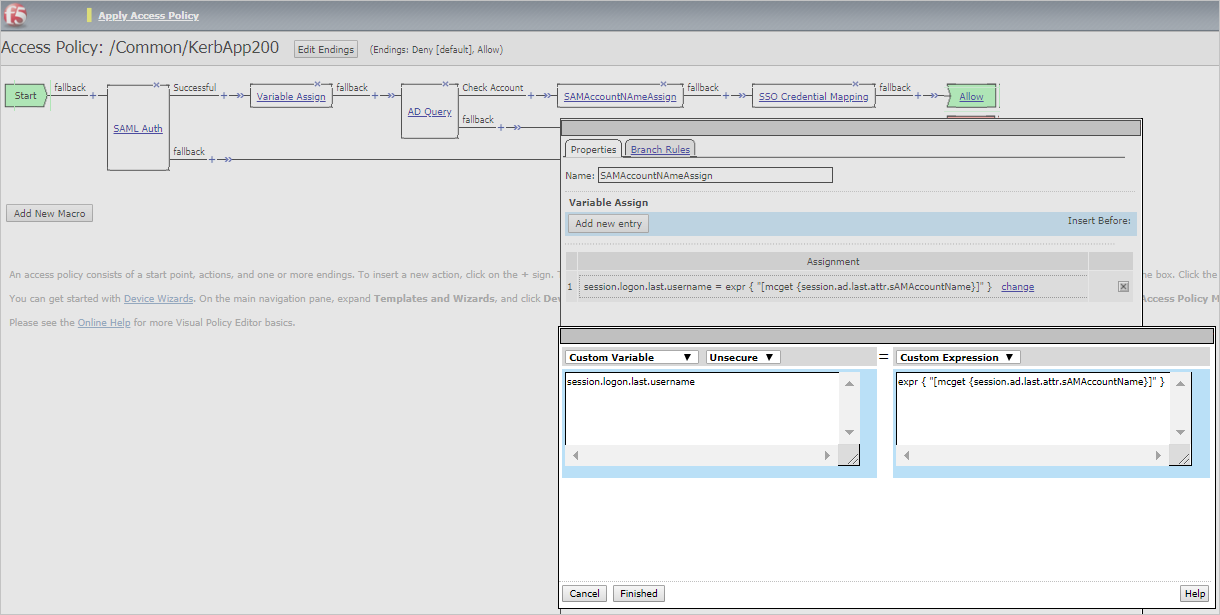
- session.logon.last.username expr { "[mcget {session.ad.last.attr.sAMAccountName}]" }

- mcget {session.logon.last.username}
- mcget {session.logon.last.password}
For adding new node, go to Local Traffic > Nodes > Node List > +.

To create a new Pool, go to Local Traffic > Pools > Pool List > Create.

To create a new virtual server, go to Local Traffic > Virtual Servers > Virtual Server List > +.
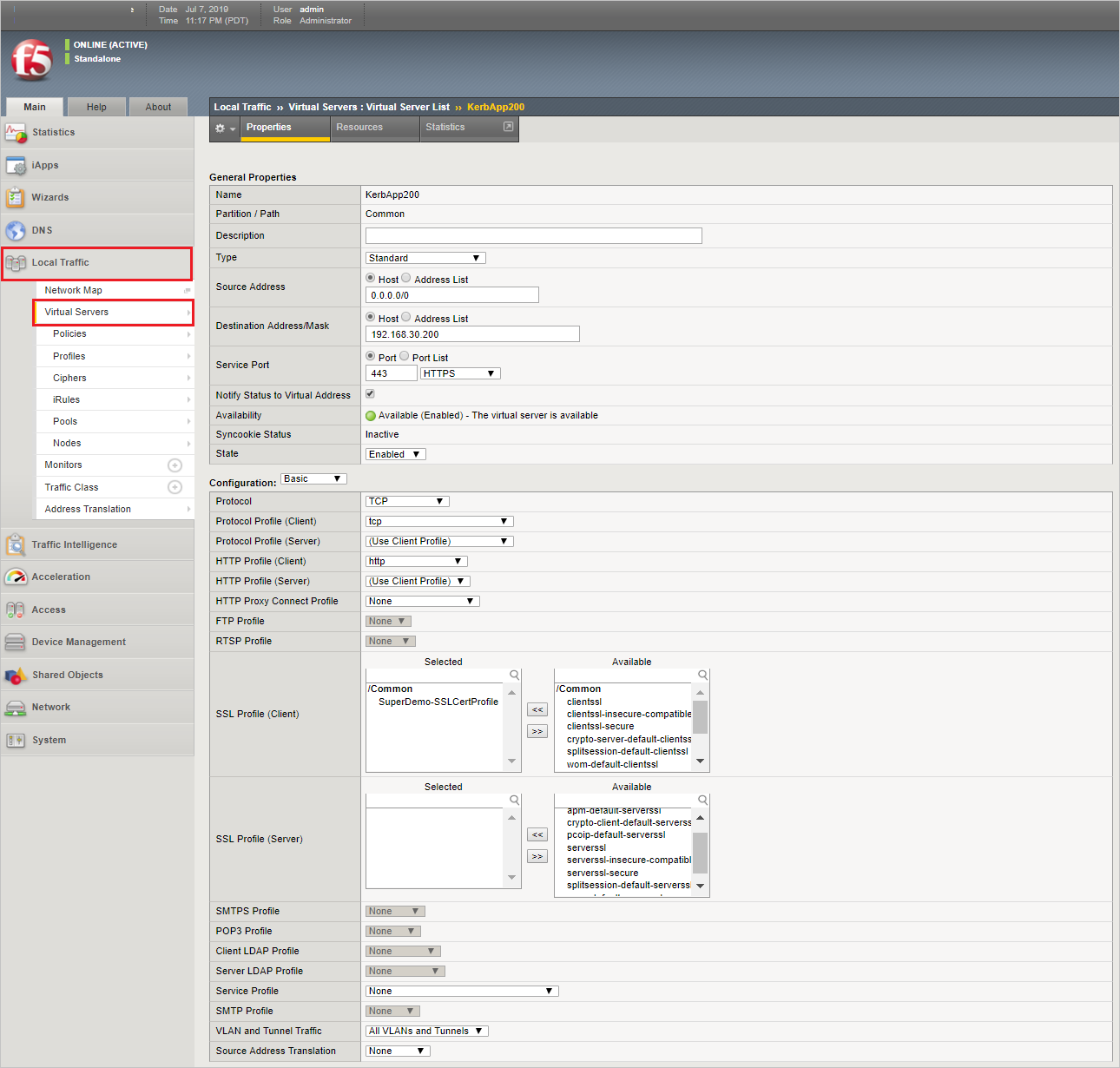
Specify the Access Profile Created in Previous Step.
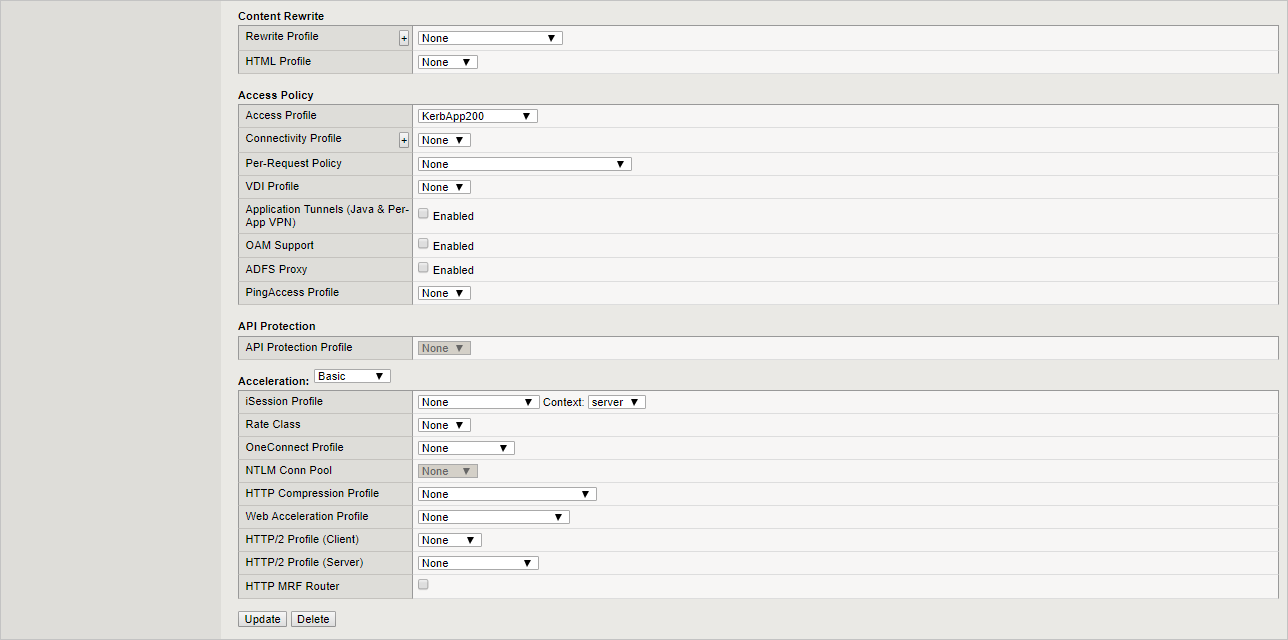
Setting up Kerberos Delegation
Note
For more details refer here
Step 1: Create a Delegation Account
- Example
Domain Name : superdemo.live Sam Account Name : big-ipuser New-ADUser -Name "APM Delegation Account" -UserPrincipalName host/big-ipuser.superdemo.live@superdemo.live -SamAccountName "big-ipuser" -PasswordNeverExpires $true -Enabled $true -AccountPassword (Read-Host -AsSecureString "Password!1234")Step 2: Set SPN (on the APM Delegation Account)
- Example
setspn –A host/big-ipuser.superdemo.live big-ipuserStep 3: SPN Delegation ( for the App Service Account)
Setup the appropriate Delegation for the F5 Delegation Account.
In the example below, APM Delegation account is being configured for KCD for FRP-App1.superdemo.live app.
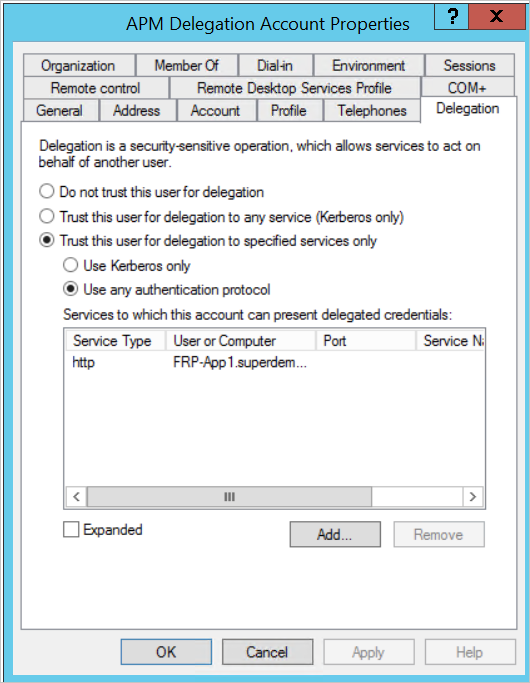
Provide the details as mentioned in the above reference document under this
Appendix- SAML – F5 BIG-IP Variable mappings shown below:
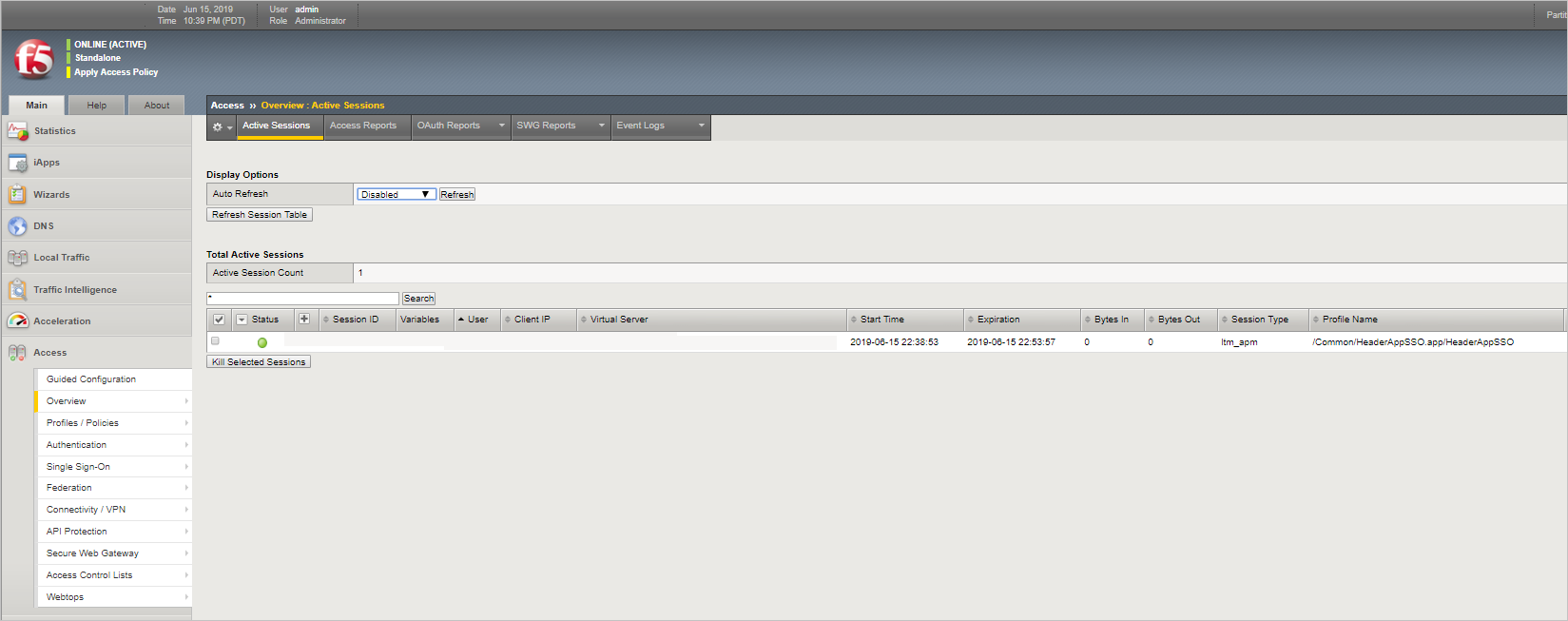
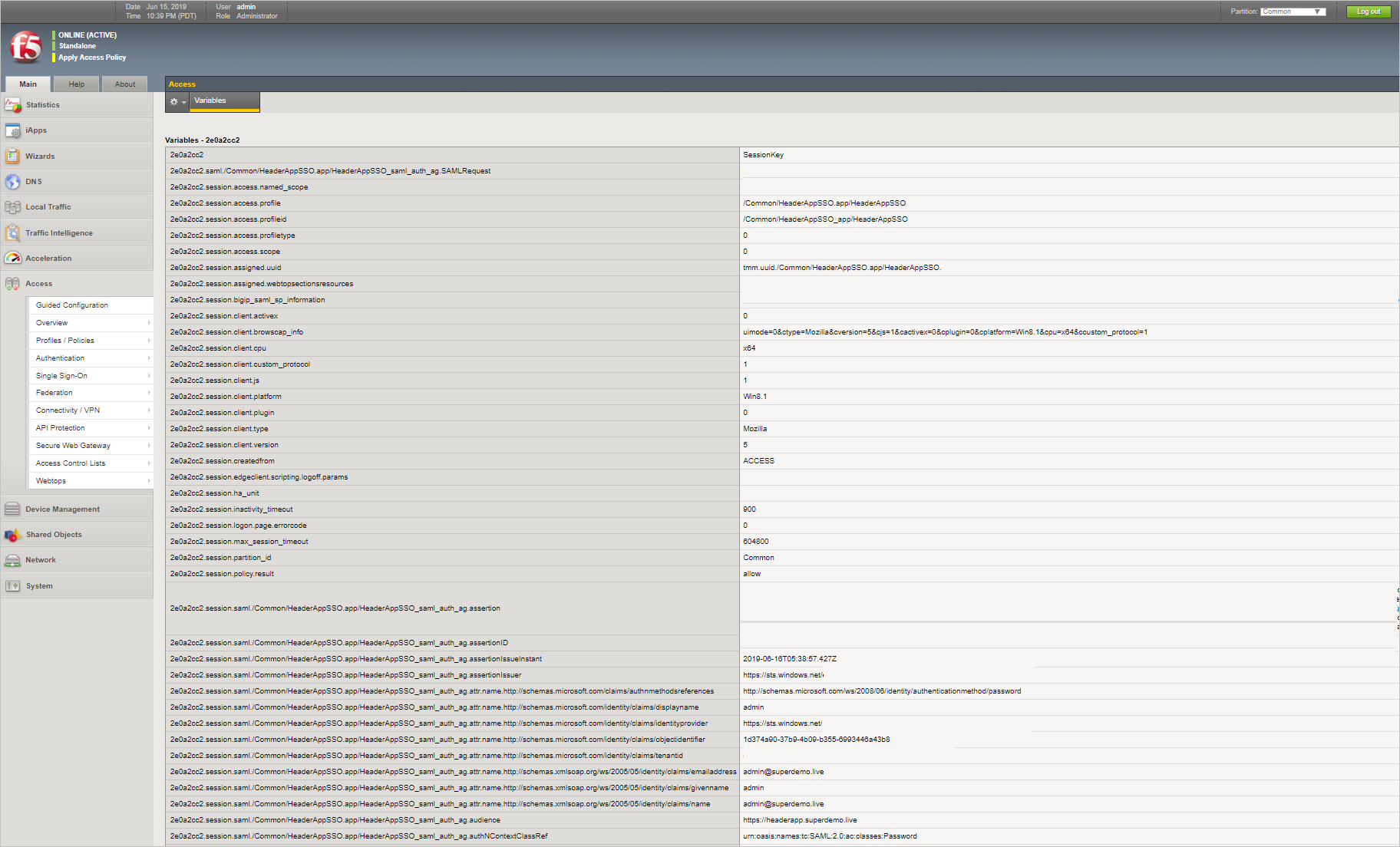
Below is the whole list of default SAML Attributes. GivenName is represented using the following string.
session.saml.last.attr.name.http://schemas.xmlsoap.org/ws/2005/05/identity/claims/givenname
| Session | Attribute |
|---|---|
| eb46b6b6.session.saml.last.assertionID | <TENANT ID> |
| eb46b6b6.session.saml.last.assertionIssueInstant | <ID> |
| eb46b6b6.session.saml.last.assertionIssuer | https://sts.windows.net/<TENANT ID>/ |
| eb46b6b6.session.saml.last.attr.name.http://schemas.microsoft.com/claims/authnmethodsreferences | http://schemas.microsoft.com/ws/2008/06/identity/authenticationmethod/password |
| eb46b6b6.session.saml.last.attr.name.http://schemas.microsoft.com/identity/claims/displayname | user0 |
| eb46b6b6.session.saml.last.attr.name.http://schemas.microsoft.com/identity/claims/identityprovider | https://sts.windows.net/<TENANT ID>/ |
| eb46b6b6.session.saml.last.attr.name.http://schemas.microsoft.com/identity/claims/objectidentifier | <TENANT ID> |
| eb46b6b6.session.saml.last.attr.name.http://schemas.microsoft.com/identity/claims/tenantid | <TENANT ID> |
| eb46b6b6.session.saml.last.attr.name.http://schemas.xmlsoap.org/ws/2005/05/identity/claims/emailaddress | user0@superdemo.live |
| eb46b6b6.session.saml.last.attr.name.http://schemas.xmlsoap.org/ws/2005/05/identity/claims/givenname | user0 |
| eb46b6b6.session.saml.last.attr.name.http://schemas.xmlsoap.org/ws/2005/05/identity/claims/name | user0@superdemo.live |
| eb46b6b6.session.saml.last.attr.name.http://schemas.xmlsoap.org/ws/2005/05/identity/claims/surname | 0 |
| eb46b6b6.session.saml.last.audience | https://kerbapp.superdemo.live |
| eb46b6b6.session.saml.last.authNContextClassRef | urn:oasis:names:tc:SAML:2.0:ac:classes:Password |
| eb46b6b6.session.saml.last.authNInstant | <ID> |
| eb46b6b6.session.saml.last.identity | user0@superdemo.live |
| eb46b6b6.session.saml.last.inResponseTo | <TENANT ID> |
| eb46b6b6.session.saml.last.nameIDValue | user0@superdemo.live |
| eb46b6b6.session.saml.last.nameIdFormat | urn:oasis:names:tc:SAML:1.1:nameid-format:emailAddress |
| eb46b6b6.session.saml.last.responseDestination | https://kerbapp.superdemo.live/saml/sp/profile/post/acs |
| eb46b6b6.session.saml.last.responseId | <TENANT ID> |
| eb46b6b6.session.saml.last.responseIssueInstant | <ID> |
| eb46b6b6.session.saml.last.responseIssuer | https://sts.windows.net/<TENANT ID>/ |
| eb46b6b6.session.saml.last.result | 1 |
| eb46b6b6.session.saml.last.samlVersion | 2.0 |
| eb46b6b6.session.saml.last.sessionIndex | <TENANT ID> |
| eb46b6b6.session.saml.last.statusValue | urn:oasis:names:tc:SAML:2.0:status:Success |
| eb46b6b6.session.saml.last.subjectConfirmDataNotOnOrAfter | <ID> |
| eb46b6b6.session.saml.last.subjectConfirmDataRecipient | https://kerbapp.superdemo.live/saml/sp/profile/post/acs |
| eb46b6b6.session.saml.last.subjectConfirmMethod | urn:oasis:names:tc:SAML:2.0:cm:bearer |
| eb46b6b6.session.saml.last.validityNotBefore | <ID> |
| eb46b6b6.session.saml.last.validityNotOnOrAfter | <ID> |
Create F5 test user
In this section, you create a user called B.Simon in F5. Work with F5 Client support team to add the users in the F5 platform. Users must be created and activated before you use single sign-on.
Test SSO
In this section, you test your Microsoft Entra single sign-on configuration using the Access Panel.
When you click the F5 tile in the Access Panel, you should be automatically signed in to the F5 for which you set up SSO. For more information about the Access Panel, see Introduction to the Access Panel.
Additional resources
List of Tutorials on How to Integrate SaaS Apps with Microsoft Entra ID
What is application access and single sign-on with Microsoft Entra ID?
F5 BIG-IP APM and Microsoft Entra integration for secure hybrid access
Tutorial to deploy F5 BIG-IP Virtual Edition VM in Azure IaaS for secure hybrid access
Tutorial for Microsoft Entra single sign-on integration with F5 BIG-IP for Password-less VPN
Feedback
Coming soon: Throughout 2024 we will be phasing out GitHub Issues as the feedback mechanism for content and replacing it with a new feedback system. For more information see: https://aka.ms/ContentUserFeedback.
Submit and view feedback for